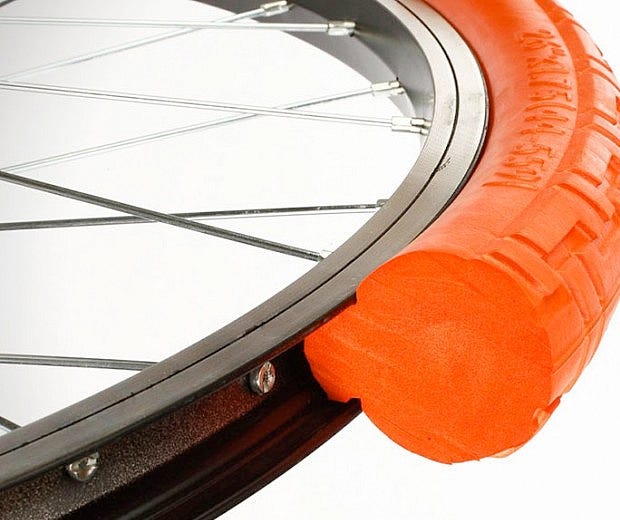Once your startup identified the right problem to solve (and ignored the wrong problems), it's time to find the right solution.
If a solution solves a problem, value is generated. As a startup, that’s what you want. In the end, all successful innovations are appropriate combinations of problems and solutions.
If they are ‘right’, the problem and solution fit neatly. Hence the name, problem-solution fit.
Within the startup journey, problem-solution fit is an important milestone.
A lot of articles on problem-solution fit lack nuance, I feel they oversimplify. There are different gradations of problem-solution fit. Allow me to demonstrate.
4 types of problem-solution fit
Example anecdote: I hate flat bicycle tires. When I was 20, I once had 3 flat tires in 1 week. I was so frustrated, I started to think of solutions.
1. Reasoned problem-solution fit
I came up with the idea of making a solid rubber tire that would never get flat. In my head, this solved the problem. This is what I call reasoned problem-solution fit. It lives on the drawing board, without evidence.
I didn't have any arguments, other than logically the features of the rubber would overcome the problem.
I wondered whether this solution existed. I found this brightly coloured solution on Google.
The product exists already, a startup-dream killed. But my problem lived on.
2. Perceived problem-solution fit
As a customer, I believed it would technically solve that problem. I was on the verge of buying, yet I didn't.
I don't remember why. Maybe I was broke as a student, as the tires were over €50.
As a founder, you should show your solution (prototype, brochure or landing page) to your customer. See if they understand how it solves their problem. If it resonates, I call this perceived problem-solution fit.
For me, (pre-)orders are a sign of perceived problem-solution fit. With a landing page, you can easily gauge perceived problem-solution fit. This comes down to the desirability of your solution.
Below, the latest version of the tire of the same brand.
3. Demonstrated problem-solution fit
Above I showed you some actual purchasable options. But, I didn't show proof that it actually solved the problem.
Some solutions have demonstrable problem-solution fit. In our example of the flat tire, we would like to see whether it gets flat when confronted with pointy things.
This is where most demos come in, teleshopping is great at this.
"Hi, Billy mays here with this new fantastic product"

What we get is the following: A demonstration of problem-solution fit in a controlled environment (video for tires). In this way, you can demonstrate problem-solution fit. This is linked to proving the feasiblity of your solution.
4. Observed in the wild problem-solution fit
Still, these tires are not in my life. To be honest, as of today, I haven't seen many solid tires on consumer bicycles. I guess it was not such a solid product after all (sorry but not sorry).
I've only seen them on some of the bicycle-sharing bikes (Mobike), and trust me (and my butt), they are very bumpy.
This brings me to the highest form of proof of problem-solution fit: solutions implemented in the lives of customers. I talk about solutions that are actually being used in real life, not just demoed in controlled environments.
With this, we get observed problem-solution fit. You can observe the solution fitting to the problems in the lives of the customers without your intervention.
For these Mobikes, I would consider observed problem-solution fit. Although according to me, there are better solutions, such as air tires.
How convincing is each type?
As with everything, I see it as a spectrum. Some of these types of ps-fit are more convincing than others. For me, reasoned is the least convincing, observed the most. Perceived and demonstrated are very close to each other in the middle; their order could also be reversed.
Buckets, not checklists.
This is not a checklist. Each type is a way to look at problem-solution fit, relating to the maturity of your startup.
See these 4 types as buckets that fill up with evidence over time. Your reasoned problem-solution fit bucket will fill up pretty fast from the start.
When you start prototyping MVPs and landing pages, your perceived and demonstrated problem-solution fit will start to slowly fill up.
When you launch (or do pilots), you will start filling the observed problem solution-fit bucket.
Most likely, your buckets start filling up from the left, slowly progressing to buckets on the right. Ask yourself, how many arguments, pieces of evidence or proof do I have for each of these types of problem-solution fit?
How was this article?
Great - Good - Meh
How was this one for you?















